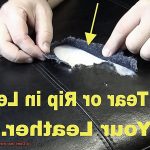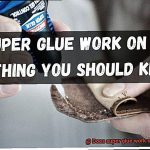Welcome to the fascinating world of spray adhesives. Are you tired of dealing with gooey, never-ending stickiness? Well, today we’re going on a deep dive into the realm of spray adhesive to answer the burning question: does it dry or stay sticky?
Spray adhesive is like a superhero for DIY projects, crafts, and home repairs. It’s a convenient aerosol-based adhesive that makes application a breeze. But what happens after you spray it on? Does it dry up like glue or leave you with surfaces that are forever stuck together?
In this blog post, we’ll explore the different types of spray adhesives and their drying properties. We’ll uncover the science behind these sticky wonders and find out if they dry completely or if they’re just clingy little troublemakers. So buckle up and get ready for an adhesive adventure like no other.
What is Spray Adhesive?
Contents
- 1 What is Spray Adhesive?
- 2 Does Spray Adhesive Dry or Stay Sticky?
- 3 Factors That Affect Drying Time of Spray Adhesive
- 4 Types of Spray Adhesives and Their Applications
- 5 Temporary Bonding and Repositionable Applications
- 6 Choosing the Right Type of Spray Adhesive for Your Project
- 7 Cleaning Residue Left Behind by Spray Adhesive
- 8 Conclusion
Spray adhesive is the go-to choice for professionals and DIY enthusiasts when it comes to gluing different materials together. With its quick and strong bond, spray adhesive is perfect for a wide range of applications. In this blog post, we will explore the characteristics of spray adhesive, its different formulations, and its uses in various industries.
The Power of Instant Hold:
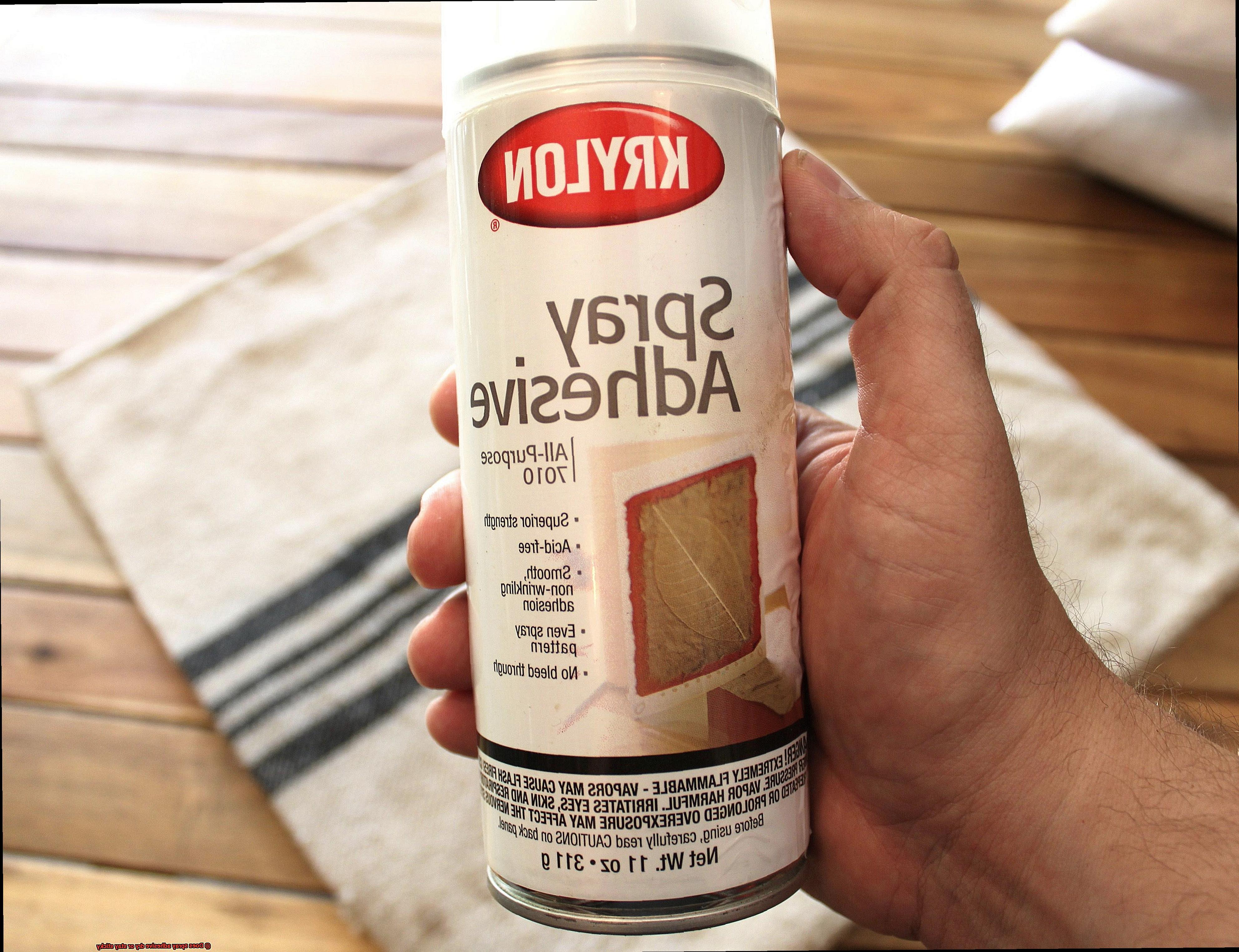
One standout characteristic of spray adhesive is its ability to create an instant hold. Unlike traditional glues that require clamping or drying time, spray adhesive bonds quickly and securely. This makes it ideal for projects that demand immediate adhesion, such as upholstery repairs or woodworking tasks.
The Science Behind Spray Adhesive:
Spray adhesive is formulated using a combination of polymers, solvents, and propellants. These chemicals work together to create a tacky surface upon contact with air. As the solvent evaporates, the glue sets and dries, forming a strong bond between the surfaces it has been applied to. Factors like temperature, humidity, and the formulation of the adhesive can influence the specific drying time.
Different Formulations for Different Needs:
Spray adhesives come in various formulations to cater to different requirements. Some adhesives dry completely and become non-tacky once cured, providing a firm bond without leaving any residue. These are commonly used in projects that demand permanent bonding, such as automotive repairs or construction tasks.
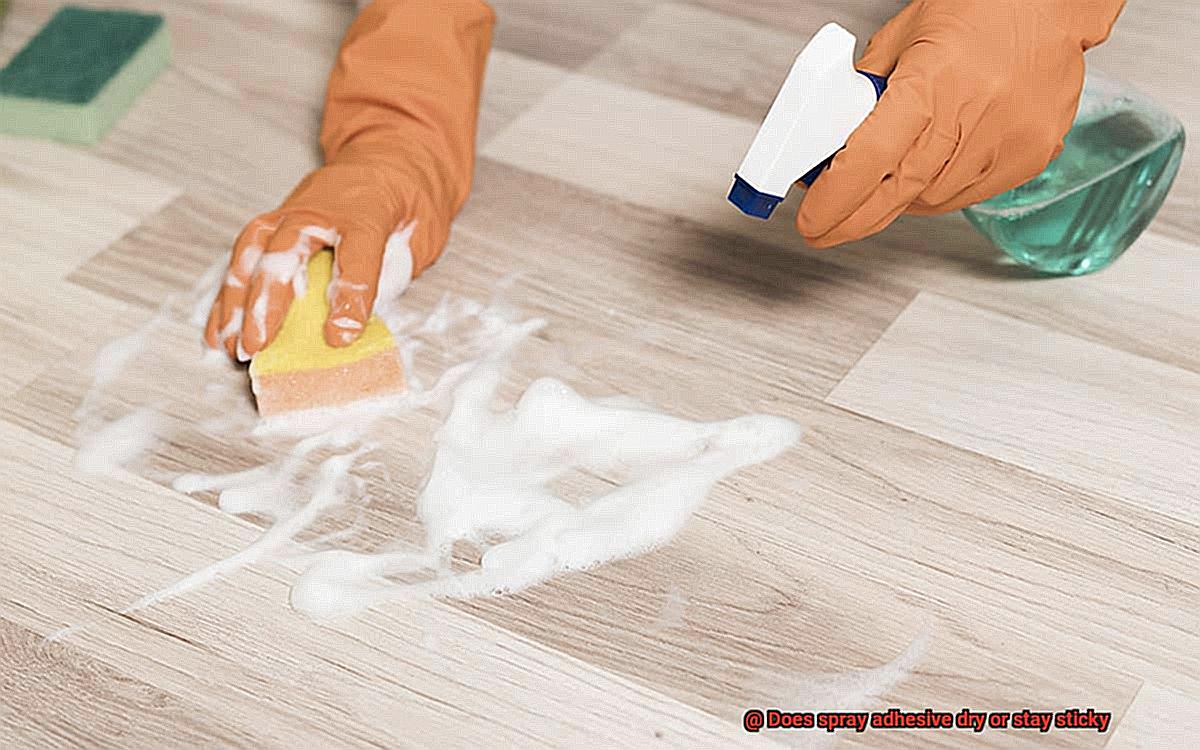
On the other hand, certain spray adhesives are intentionally designed to retain a slight stickiness even after drying. These adhesives offer flexibility and repositionability and are often used in crafts, scrapbooking, or temporary bonding applications.
Applications Across Industries:
Spray adhesive finds its place in numerous industries due to its versatility. It is commonly used in woodworking to bond veneers or laminates, in upholstery for attaching fabric to foam or wood, and in automotive repairs for securing carpets or headliners. Additionally, it is a valuable tool in the crafting world, allowing for precise and efficient bonding of various materials.
Advantages of Spray Adhesive:
- Quick and instant bond: Spray adhesive creates an immediate hold, eliminating the need for clamping or waiting for the glue to dry.
- Versatility: With different formulations available, spray adhesive can be used for both permanent bonding and temporary applications.
- Easy application: The aerosol can allows for easy and precise spraying, ensuring even coverage and minimal mess.
- Clear and residue-free: Most spray adhesives dry clear, leaving no visible residue on the bonded surfaces.
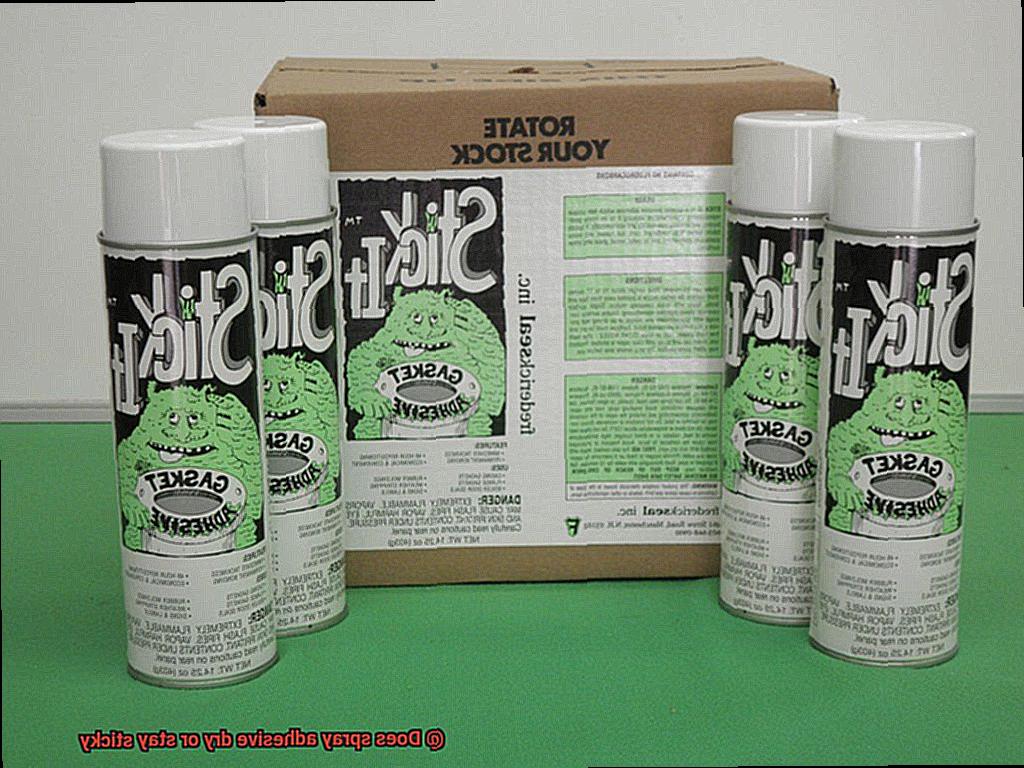
Does Spray Adhesive Dry or Stay Sticky?
Spray adhesive is a versatile glue that comes in an aerosol can, making it convenient for a variety of crafting and woodworking projects. But does it fully dry or does it remain sticky? The answer is not a simple one. Let’s explore the factors that contribute to the drying process of spray adhesive.
When you first apply spray adhesive, it feels sticky and tacky to the touch. This initial stickiness might make you wonder if it will ever dry. Fear not, for spray adhesive is indeed designed to dry completely. However, the drying time can vary depending on several factors.
Temperature, humidity, and the type of material you are applying the adhesive to all play a role in how quickly it dries. In general, spray adhesives dry relatively fast, typically within minutes to an hour. During this process, a chemical reaction occurs, transforming the adhesive from a liquid or sticky state to a solid and non-tacky state.
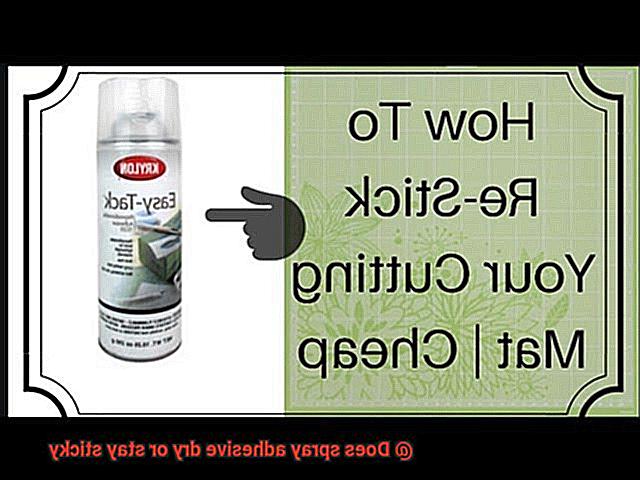
Once fully dried, the adhesive should no longer feel sticky. It should have a firm and dry texture, providing a secure bond for your project. However, there are instances where certain types of spray adhesive may leave behind a slight tacky residue even after drying. This can be more common with specific brands or formulations.
To ensure optimal results when using spray adhesive, it is crucial to follow the instructions provided by the manufacturer. Understanding the specific drying characteristics of the adhesive will help you achieve the desired outcome.
If you find that your spray adhesive remains sticky after drying, several reasons could be at play. Improper application, excessive use of adhesive, or applying it on incompatible surfaces can all contribute to this issue. In such cases, it may be necessary to consider using a different adhesive or exploring alternative solutions for your specific project.
Factors That Affect Drying Time of Spray Adhesive
Spray adhesive is a popular choice for bonding materials together due to its convenience and efficiency. However, one common concern among users is the drying time of the adhesive. The time it takes for spray adhesive to dry can vary based on several important factors, which we will explore in this comprehensive passage.
First and foremost, the type of spray adhesive being used can significantly impact drying time. Different adhesives are formulated with varying drying times in mind. Some adhesives are designed to dry quickly, allowing for immediate bonding, while others may require a longer period of time to fully dry. It is essential to consult the product label or manufacturer’s instructions to determine the expected drying time for a specific type of spray adhesive.
The environment in which the adhesive is applied also plays a crucial role in its drying time. Temperature and humidity levels can greatly affect how quickly or slowly the adhesive dries. Higher temperatures generally expedite the drying process, while lower temperatures can prolong it. Similarly, low humidity levels promote faster drying, while high humidity can slow it down. To achieve optimal results, it is recommended to work in a well-ventilated area with moderate temperature and humidity conditions.
The porosity of the surfaces being bonded is another factor that influences drying time. Porous surfaces such as wood or fabric tend to absorb the adhesive more readily, resulting in faster drying times. On the other hand, non-porous surfaces like metal or glass may take longer to dry as the adhesive sits on the surface without being absorbed.
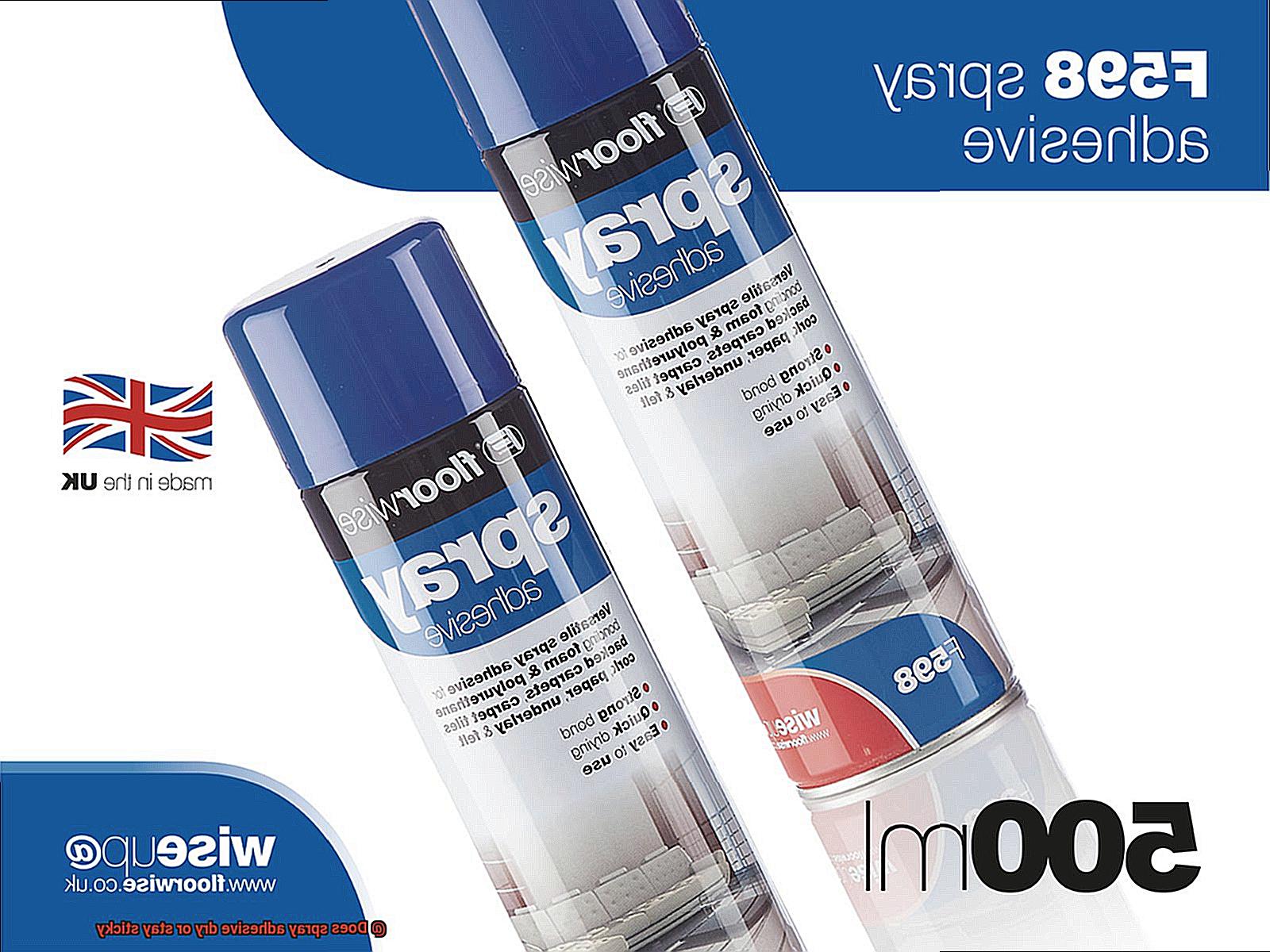
The thickness of the adhesive layer applied also affects drying time. Thicker layers take longer to dry as there is more material that needs to evaporate or set. To expedite drying and ensure efficient bonding, it is best to apply a uniform and thin layer of spray adhesive.
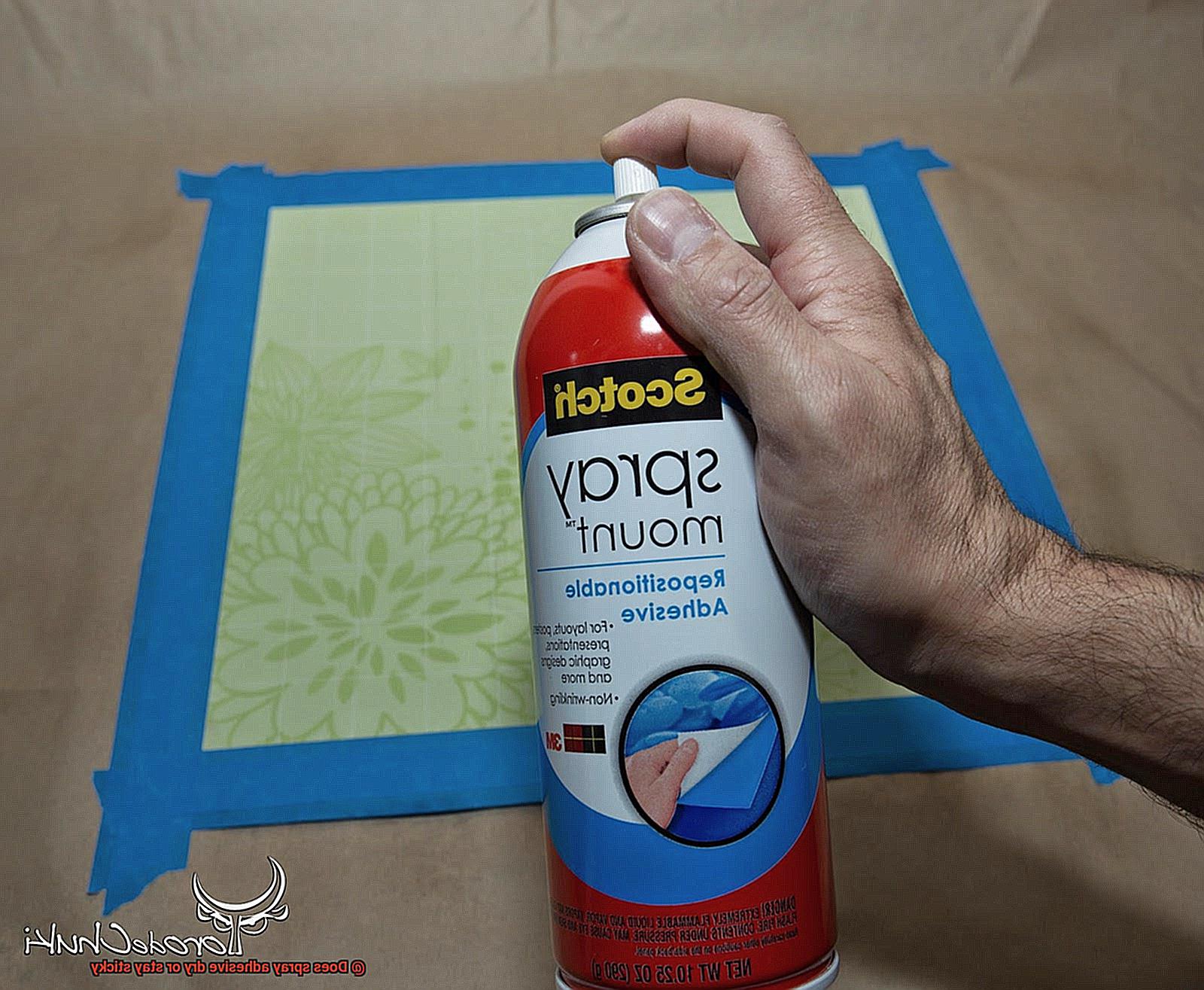
Additionally, the temperature of the materials being bonded can impact drying time. Cold materials can slow down the drying process, while warmer materials can help accelerate it. It is advisable to pre-warm or acclimate the materials to room temperature before applying the adhesive for optimal drying results.
Proper ventilation and airflow are crucial considerations as well. Adequate ventilation allows for quicker evaporation of the solvent or carrier in the adhesive, leading to faster drying. Opening windows or using fans can help ensure proper airflow during the drying process.
Lastly, the specific formulation of the spray adhesive can affect its drying time. Different adhesives contain varying amounts of solvents, resins, or other chemical components that influence drying characteristics. It is essential to choose an adhesive that aligns with your specific needs and desired drying time.
Types of Spray Adhesives and Their Applications
These magical glues, housed in cans of wonder, have the power to bond practically anything together. Today, we will immerse ourselves in the diverse types of spray adhesives and their incredible applications. Brace yourselves for an adventure of creativity and innovation.
Aerosol Adhesives:
Picture a can that unleashes glue like a superhero’s web, drying at lightning speed to create an unbreakable bond. That’s the magic of aerosol adhesives. With their super-fast drying time, they are ideal for sticking paper, fabric, or even lightweight materials such as foam. Available in various strengths, you can choose between temporary bonding or a more permanent solution.
Contact Adhesives:
When you require Herculean strength and unrivaled durability, contact adhesives come to your rescue. These sprays must be applied to both surfaces you wish to bond. After a brief drying period, press the two surfaces together and witness the birth of an instant bond. Contact adhesives are perfect for laminating countertops or adhering heavy materials like rubber or leather.
Multipurpose Adhesives:
If versatility is what you seek, look no further than multipurpose adhesives. They are your trusty companions for all types of materials: wood, metal, plastic, fabric, and even paper. Tailor your project by choosing between temporary bonding or a permanent sealant.
Specialty Adhesives:
Certain projects demand specialized solutions. Enter specialty adhesives. For instance, photo-safe spray adhesives are a godsend when preserving precious memories without damage. Working with foam materials? Fear not. There are sprays designed specifically for bonding upholstery foam or foam insulation.
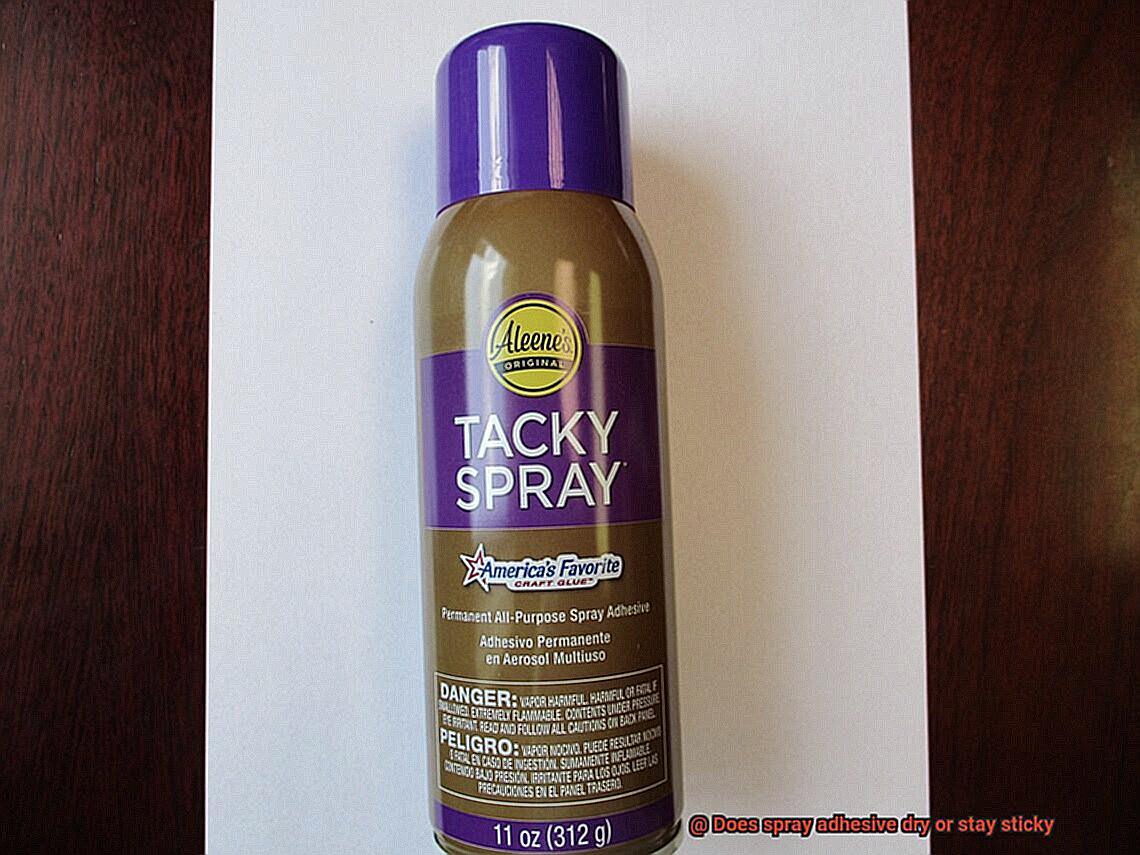
Temporary Bonding:
Imagine crafting a masterpiece, rearranging the elements until perfection strikes. Temporary adhesives are your saviors in such moments. These sprays allow for effortless repositioning or removal without leaving any sticky residue behind. Whether you’re a passionate crafter or simply planning your project, temporary adhesives are your best friends.
Temporary Bonding and Repositionable Applications
Today, we embark on a thrilling journey through the realm of temporary bonding and repositionable applications. Get ready to revolutionize your projects as we explore the endless possibilities these adhesive wonders offer.
Advantages of Spray Adhesives for Temporary Bonding:
- Instant Bonding: Spray adhesives work their magic with quick-drying power. They create an immediate bond between surfaces, eliminating any precious time wasted waiting for glue to dry. Your projects can move forward without delay.
- Easy Repositioning: Mistakes happen, but with spray adhesives, they’re easily fixable. Unlike permanent adhesives, these wonders provide a temporary bond that allows you to peel surfaces apart and readjust without damaging materials. Say goodbye to irreversible mishaps.
- Flawless Precision: For projects demanding precision and alignment, spray adhesives are your secret weapon. They allow you to position materials with exactness, ensuring flawless results every time.
Advantages of Spray Adhesives for Repositionable Applications:
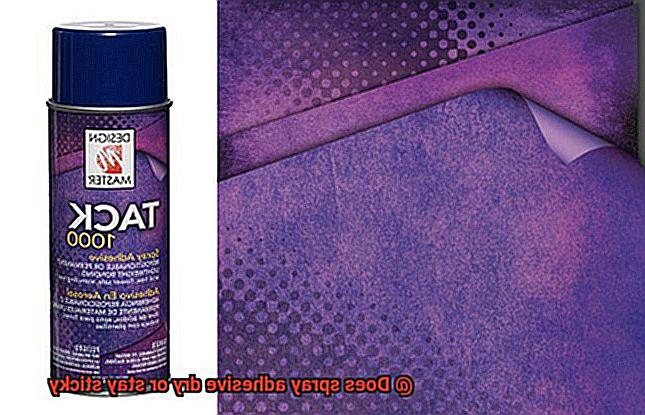
- Endless Repositionings: Imagine having the freedom to reposition items over and over again without losing adhesive power. Spray adhesives designed for repositionable applications possess a tacky consistency that adheres well to various surfaces while facilitating easy removal and reapplication.
- Residue-Free Removal: The beauty of spray adhesives lies in their clean removal process. Whether you’re rearranging wall decals or stickers, these magical sprays ensure residue-free removal, leaving surfaces spotless and ready for your next creative endeavor.
- Tailored Stickiness: It’s essential to know that not all spray adhesives are created equal. Some dry completely, losing their adhesive properties over time, while others maintain a slight tackiness even after drying. To find the perfect adhesive for your needs, read instructions and product specifications carefully.
Spray adhesives are the creative wizard’s best friend when it comes to temporary bonding and repositionable applications. Their instant bonding, easy repositioning, and residue-free removal make them invaluable tools for any project.
Remember to choose the right adhesive by understanding their characteristics and intended uses. Now that you’re armed with this knowledge, it’s time to let spray adhesives work their magical wonders and take your projects to new heights.
Choosing the Right Type of Spray Adhesive for Your Project
Spray adhesives are here to save the day. But wait, before you rush out and grab the first can of adhesive you see, there are a few key factors you should consider to ensure you choose the right type of spray adhesive for your project. So buckle up and get ready for some adhesive enlightenment.
First on our list is bonding strength. Different projects require different levels of adhesion. If you’re working on a heavy-duty project that needs to withstand extreme conditions, you’ll want an adhesive with a strong bond. On the other hand, if you’re working on something temporary or need to reposition your materials, a less sticky adhesive may be more suitable.
Next, consider the materials you’ll be working with. Adhesives aren’t one-size-fits-all, so it’s important to choose one that is compatible with the materials you’re using. For example, if you’re working with fabric, look for an adhesive specifically designed for textiles. If you’re working with wood or plastic, make sure your adhesive is formulated for those materials.
Now let’s talk about application method. Spray adhesives come in various forms – aerosol cans, pump bottles, or trigger sprayers. The application method can affect how evenly and precisely the adhesive is sprayed onto the surface. Consider the size of your project and the level of control you need when choosing an application method.
Don’t forget about any specific requirements or restrictions of your project. If you’re working in an enclosed space, choose an adhesive with low VOC content to minimize fumes. If you have a tight deadline or need to handle the bonded materials shortly after application, opt for an adhesive with a quick drying time.
Cleaning Residue Left Behind by Spray Adhesive
Let’s dive in and banish that residue once and for all.
- Determine the Surface: The first step is to identify the type of surface you’re dealing with. Different surfaces may require different cleaning methods to avoid damage.
- Non-Porous Surfaces: For glass, metal, or plastic surfaces, a solvent is your best friend. Try using acetone, isopropyl alcohol, or a commercial adhesive remover. Apply the solvent to a clean cloth or sponge and gently rub the residue until it loosens. Repeat this process if necessary until it’s completely gone.
- Porous Surfaces: If you’re tackling fabric or wood, start by scraping off as much dried adhesive as possible using a plastic scraper or dull knife. Be gentle to avoid scratching the surface. Next, mix a small amount of liquid dish soap with warm water and apply it to a clean cloth or sponge. Gently dab at the remaining residue, rinsing the cloth frequently. Avoid vigorous rubbing to prevent spreading the adhesive further.
Remember to test any cleaning method on a small, inconspicuous area first to ensure it doesn’t cause damage.
- Final Touches: Once the adhesive residue is removed, clean the surface with mild soap and water to remove any remaining cleaning solution.
- Pro tip: Prevention is key. Follow the manufacturer’s instructions on drying times and application techniques. Allowing the adhesive to fully dry before contact with other objects will minimize residue.
IPd8vzIZpbE” >
Conclusion
Spray adhesive, the versatile wonder of the crafting world, offers a swift and mighty bond for all your project needs. But does it dry or stay sticky? Fear not, for most spray adhesives do indeed dry completely, transforming from a clingy state to a solid and non-tacky one. However, keep in mind that drying times can vary depending on factors such as temperature, humidity, material type, and adhesive formulation.
There’s a plethora of spray adhesives out there to cater to every whim. Some dry completely without leaving any trace behind, perfect for those permanent fixes in automotive repairs or construction endeavors. Others are intentionally designed to retain a hint of stickiness even after drying, offering flexibility and repositionability for your artistic exploits or temporary bonding needs.
To achieve optimal results with spray adhesive, heed the manufacturer’s instructions like they’re golden rules. Proper application technique, selecting the right adhesive for your specific project, and considering environmental conditions can greatly impact the drying process.
If you find yourself stuck with a persistently sticky spray adhesive after it’s supposed to be dry, it may be time to explore alternative solutions or try different types of adhesives that better align with your desires. Remember: understanding the characteristics and drying properties of spray adhesive is key to unlocking successful bonding in your projects.




